Jhelum River
- "Hydaspes" redirects here. For the historic battle, see Battle of the Hydaspes.
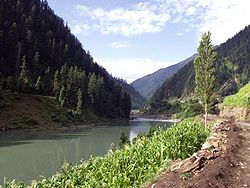
Jehlum River or Jhelum River (Sanskrit: वितस्ता, Kashmiri: Vyeth, Hindi: झेलम, Punjabi: ਜੇਹਲਮ (Gurmukhi), دریاۓ جہلم (Shahmukhi)) is a river that flows in India and Pakistan. It is the largest and most western of the five rivers of Punjab, and passes through Jhelum District. It is a tributary of the Chenab River and has a total length of about 480 miles (774 kilometers).
Contents |
History
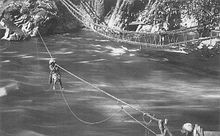
The river Jhelum is called Vitastā in the Rigveda and Hydaspes by the ancient Greeks. The Vitasta (Sanskrit: वितस्ता, fem., also, Vetastā) is mentioned as one of the major rivers by the holy scriptures of the Indo-Aryans — the Rigveda. It has been speculated that the Vitastā must have been one of the seven rivers (sapta-sindhu) mentioned so many times in the Rigveda. The name survives in the Kashmiri name for this river as Vyeth. According to the major religious work Srimad Bhagavatam, the Vitastā is one of the many transcendental rivers flowing through the land of Bharata, or ancient India.[1]
The river was regarded as a god by the ancient Greeks, as were most mountains and streams; the poet Nonnus in the Dionysiaca (section 26, line 350) makes the Hydaspes a titan-descended god, the son of the sea-god Thaumas and the cloud-goddess Elektra. He was the brother of Iris, the goddess of the rainbow, and half-brother to the Harpies, the snatching winds. Since the river is in a country foreign to the ancient Greeks, it is not clear whether they named the river after the god, or whether the god Hydaspes was named after the river. Alexander the Great and his army crossed the Jhelum in BC 326 at the Battle of the Hydaspes River where he defeated the Indian king, Porus. According to Arrian (Anabasis, 29), he built a city "on the spot whence he started to cross the river Hydaspes", which he named Bukephala (or Bucephala) to honour his famous horse Bukephalus or Bucephalus which was buried in Jalalpur Sharif. It is thought that ancient Bukephala was near the site of modern Jhelum City. According to a historian of Gujrat district, Mansoor Behzad Butt, Bukephalus was buried in Jalalpur Sharif, but the people of Mandi Bahauddin, a district close to Jehlum, believed that their tehsil Phalia was named after Bucephalus, Alexander's dead horse. They say that the name Phalia was the distortion of the word Bucephala. The waters of the Jhelum are allocated to Pakistan under the terms of the Indus Waters Treaty.
Verinag In Kashmir
Verinag is situated at a distance of approximately 80 km from Srinagar. Reached through the link road, it is located at a height of 1,876 m. It is believed that the Verinag spring in Kashmir is the chief source of the river Jhelum. There is an octagonal base at the spring, surrounded by a covered passage.
Considered to be the source of the River Jhelum, often termed as the lifeline of the province of Jammu and Kashmir, the beautiful region of Verinag is indeed one of the best options of a weekend getaway from Srinagar. A tour to Verinag reveals the secret of the source of the River Jhelum, a spring after which the region itself has been named.
The Verinag Spring, named after Nila Nag, the son of the famous Hindu sage Kashyap Rishi, to whom, goes the credit of establishing the territory of Jammu and Kashmir is one of the principle tourist attractions of a tour to Verinag. the spring, which was originally shaped in a circular form was given a change of shape during the reign of the Mughal Emperor Jahangir in 1620, when he gave orders to renovate the spring in the Mughal traditional shape of an octagon. Today, picturesque in its settings and surrounded by tall Pine trees, the Verinag Spring is characterized by waters which are calm and sparklingly clear. Besides a glimpse of the Verinag Spring, a tour to Verinag is made even more special by the sight of several varieties of colorful flowers, gently swaying to the rhythm of the cool, mountain air.
The easiest way of reaching Verinag is by air. The nearest airport is at the Badgam District around 80 km away from the village of Verinag.
The nearest railhead to Verinag is at Jammu from where it takes an approximate time of around an hour to reach Verinag.
Verinag is well-connected to a number of other regions of Jammu and Kashmir. There are a number of well maintained roads which lead to Verinag.
Course
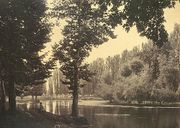
The river Jhelum rises from a spring at Verinag situated at the foot of the Pir Panjal in the south-eastern part of the valley of Kashmir in India. It flows through Srinagar and the Wular lake before entering Pakistan through a deep narrow gorge. The Kishenganga (Neelum) River, the largest tributary of the Jhelum, joins it, at Domel Muzaffarabad, as does the next largest, the Kunhar River of the Kaghan valley. It also connects with Pakistan and Pakistan-held Kashmir on Kohala Bridge east of Circle Bakote. It is then joined by the Poonch river, and flows into the Mangla Dam reservoir in the district of Mirpur. The Jhelum enters the Punjab in the Jhelum District. From there, it flows through the plains of Pakistan's Punjab, forming the boundary between the Chaj and Sindh Sagar Doabs. It ends in a confluence with the Chenab at Trimmu in District Jhang. The Chenab merges with the Sutlej to form the Panjnad River which joins the Indus River at Mithankot.
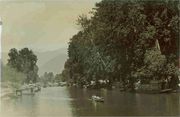
Dams and barrages
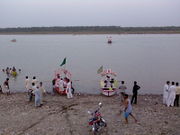
Water control structures are being built as a result of the Indus Basin Project, including the following:
- Mangla Dam, completed in 1967, is one of the largest earthfill dams in the world, with a storage capacity of 5.9 million acre-feet (7.3 km³)
- Rasul Barrage, constructed in 1967, has a maximum flow of 850,000 ft³/s (24,000 m³/s).
- Trimmu Barrage, constructed in 1939 some 90 km from Mari Shah Sakhira town, at the confluence with the Chenab, has maximum discharge capacity of 645,000 ft³/s (18,000 m³/s).
- Harahpur (Victoria Bridge) Constructed in 1933 Approximate 5 km from malakwal near Chak nizam Village. Its length is 1 km mainly used by Pakistan Railways but there is a passage for light vehicle (motor cycle, cycle and by boot at both side.
Canals
- The Upper Jhelum Canal runs from Mangla Dam to the Chenab.
- The Rasul-Qadirabad Link Canal runs from the Rasul Barrage to the Chenab.
- The Chashma-Jhelum Link Canal runs from the Chashma Barrage on the Indus River to the Jhelum river downstream of Rasul Barrage. This is 40 km away from Mari Shah Sakhira town.
References
- ↑ "Bhaktivedanta VedaBase: Srimad Bhagavatam 5.19.17-18". 2010-01-04. http://srimadbhagavatam.com/sb/5/19/17-18/en1. Retrieved 2008-01-04.
External links
- Livius.org pictures of the Hydaspes
- Official website of Jhelum – Urdu Version
- Veth Jhelum Vitasta
- Official website of Jhelum – English Version
|
|||||||||||
|
|||||||
|
|||||||||||